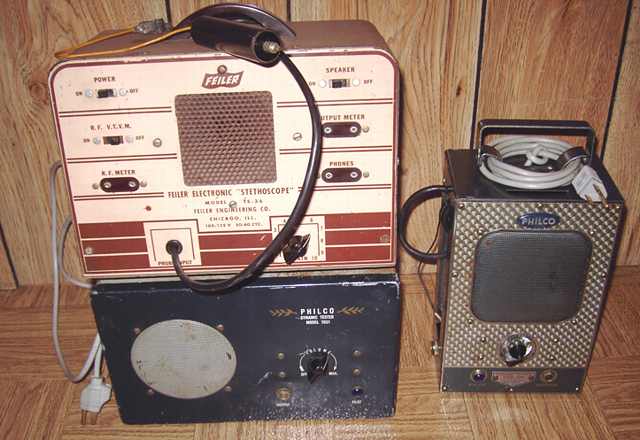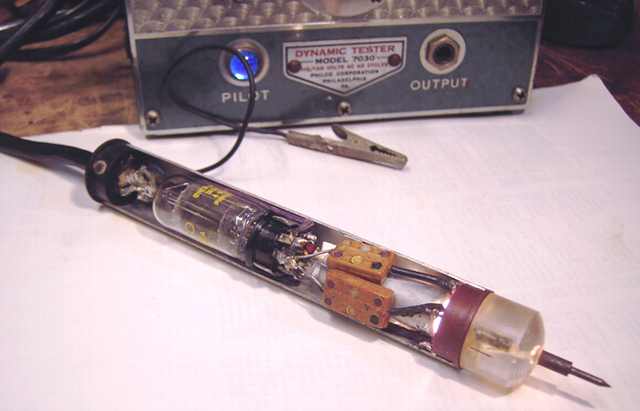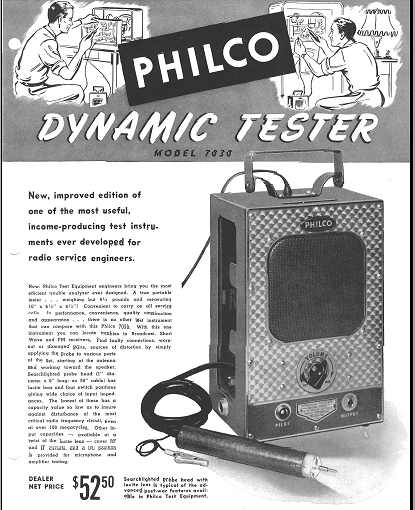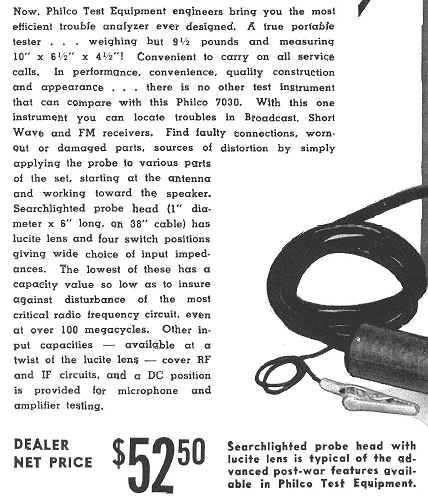Feiler TS-3A, top left - Philco 7031, bottom left- Philco 7030, right

I like old tube test equipment. Signal tracers have always been part of the hobby for me. They are handy for tracing radio and audio signals from the antenna or microphone or phono cartridge all the way to the speaker.
Signal tracers come in several versions. Some are complete TRF radios in themselves, mostly based on Rider's original Chanalyst .
Most other signal tracers are untuned with a two or three stage audio amplifier and a demodulator probe. Of the untuned variety, most use a germanium diode like an untuned crystal radio. The Philco 7030 and 7031 Dynamic Tester and the Feiler Engineering TS-3A Electronic "Stethoscope" are special in the use of a vacuum tube inside the probe.

Feiler TS-3A
The Feiler "Stethoscope" has a 6C4 triode inside the probe. I recently replaced the working but worn probe cable with a piece of computer power cord, the shielded variety. Only three wires are needed by the probe, one of which is the shield and ground return. The cathode and one side of the filament are connected to ground. The other wires carry the 6.3 volts for the filament and the plate feed with its signal and B+ leading to a coupling cap and B+ load resistor located in the tracer itself. The grid has a grid leak resistor and a small cap to the probe point.
I have owned the Feiler for quite some time and previously replaced its capacitors. Preventive maintenance involves little more than an occasional contact cleaning for its tube sockets and volume control. It has always been a reliable old piece.
The Philco 7030
The Philco 7030 and 7031 have nearly identical circuitry but are worlds apart in cabinet design. The 7030 is a nice metallic blue with a chromed brass front panel decorated with engine turnings. Even its handle is a nice design for wrapping the power cord. The 7031 is a basic lunch box design. I had a 7030 that was missing its probe. More recently, I acquired the 7031. Both have the same tube lineup with the same circuit and identical probes. The main amp uses 3 loctal tubes; a 7Y4 rectifier, 7A5 audio output, and 7L7 amplifier. A seven pin miniature 6AQ6 is inside the probe. Only its triode section is used. I decided to complete the 7030 with the probe from the 7031.

While the Feiler uses a similar circuit to the Philco pair, the Philco probe is unique. The Feiler uses one fixed cap in its grid circuit. The Philco has several selections. The front of the probe turns and switches four different input choices to allow for limiting the loading of the test circuit. Position "3" selects a 470 pF cap for IF circuits. Position "2" selects a 4.7 pF cap for RF circuits. Position "M" selects a 220 K ohm resistor for audio. Position "1" has no direct connection, but can be used for picking up signals in high impedance test circuits without loading.

And one more feature. The Philco has a built-in light for illuminating the device to be tested. A 6 volt bulb shines light through the transparent plastic probe insulator.
Repairing the Philco 7030
The electrolytics reformed easily, but I replaced all of the wax caps. The power cord was replaced with a grounded 3-wire version. I removed the powerline to chassis caps since the 3-wire arrangement with grounded chassis eliminates the need for those caps in this device.
Comparing the Feiler and the Philco
Both will readily do a fine job of signal tracing with essentially the same 3 stage audio amplifier including the tube in the probe. The Philco with its probe impedance selector switch and the light in the probe is a bit more versatile. The Philco 7030 is certainly the more compact and elegant design for looks, a real keeper.
A Philco brochure on the 7030 was made available courtesy of Chuck Schwark. Thanks Chuck. Date on the brochure is 1946. Here is the cover ad from the brochure.


A Panoramic Radio SB-8b Panalyzor was the previous item on the bench.